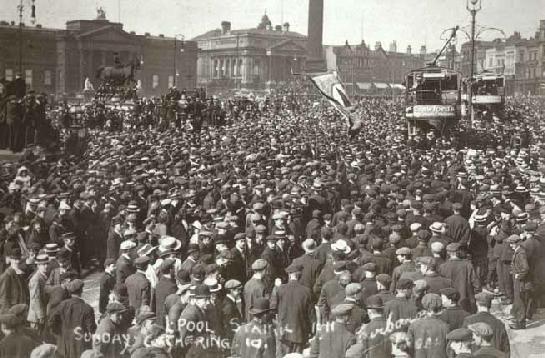Near to revolution? – Liverpool 1911
On Sunday 8 October around 120 people attended: ‘Near To Revolution? The 1911 Liverpool general transport strike centenary conference’.
Eric Taplin, author of the book from which the conference took its name, opened the conference with a history of the great strike.
He dealt with the inspirational role played by Tom Mann in giving leadership to the mighty strike movement which eclipsed anything which had gone before.
He spoke of the deployment of extra police and troops to Liverpool, the shooting dead of two striking workers – which united many catholic and protestant workers previously divided by sectarianism, and he explained in detail how ultimately the mass action led to the tremendous achievements of the strike, which secured better living standards and trade union recognition from the employers.
The second and third sessions were divided into workshops.
Richard Hyman, emeritus professor, LSE and Ralph Darlington, author of ‘Syndicalism and the Transition to Communism’, in separate sessions dealt with the subject of syndicalism. Both pointed out that syndicalists rejected bureaucratic structures as a result of the failure of leaderships in both the Labour Party and the trade union movement but when asked what exactly syndicalism is, neither gave a clear answer. Richard Hyman said: “syndicalism knows what it isn’t but means different things to different people at different times”.
The mid afternoon session was the highlight of the day. A panel which comprised of Bob Crow, RMT, John McDonnell, LRC, Tony Mulhearn Socialist Party and Charlie Kimber, SWP, led the debate.
All drew on the lessons of the 1911 strike and the need to repeat the sort of solidarity achieved at that time.
Tony Mulhearn emphasised that the conference’s purpose was not merely to have an academic assessment of 1911 but to draw on the magnificent example of that mass movement inspired by a leadership which was prepared to go the distance to achieve great advances for the working class.
He reminded us that Liverpool’s Militant Labour council of 1983 drew on those lessons in translating socialism into the language of jobs, services and new houses, backed up by a mass movement of trade unions and the District Labour Party (including its youth and women’s sections) which drew behind them large sections of Liverpool’s workers.
Audience questions
Questions were invited from the floor and when asked how Labour Party members could fight against cuts imposed by Labour councils, John McDonnell was unequivocal, saying that where Labour councils impose Tory cuts then they become the enemy and must be fought as such.
He also paid tribute to the achievements of the 47 Labour councillors (who led the Socialist Liverpool council of 1983-87) and said he was proud to share a platform with Tony Mulhearn.
Emerging from the debate was the question: how to harness and lead the deep-rooted anger of workers and their total opposition to the manic cuts programme being bludgeoned through by the Con-Dem alliance, and implemented by local authorities.
Bob Crow, in a powerful speech, argued that now is not the time for ‘sectarian posturing’ but time to develop a mass movement of opposition which millions could identify with.
Tony Mulhearn echoed this call for a broad based movement of the left which could appeal to the mass of youth and workers on a clear programme of working class demands which the mass of workers could identify with. ‘I am a member of the Socialist Party’, he said, ‘and I’d like everybody here to join us, but I doubt that will happen’, but we can all unite on a clear programme committed to mobilising millions against the Con-Dems, based on a programme of opposition to privatisation and for a policy of nationalisation’.
I asked, in view of the outlook of Labour leader Ed Miliband and his acolytes in attacking trade union strike action, if the panel agreed that the trade unions should break their link with the Labour Party. There was a general consensus that this objective should be campaigned for.
There was general agreement that the local authority trade union leadership was lacking in the dynamism now needed to develop a strategy which could arm their members in defending their jobs and conditions, and the anti-cuts committees would have to appeal to local authority workers to join them in their campaigns.
The final session was divided into workshops. Francey Devine, author of ‘A 100 Year History of the IT&GWU’ led a discussion on the subject of the 1913 Dublin lockout and the role of big Jim Larkin.
He told how the employers tried to starve workers into submission and how workers responded with great stoicism and fortitude.
This was exhibited by strikers after food ships, organised by Jim Larkin, brought desperately needed supplies.
The strikers shared their food through their communities and they in turn saw the importance of solidarity amongst their class.
The emotions of the people poured out into songs which Francey performed as part of his presentation. These songs are available on his facebook page.
The conference was valuable in not only allowing activists to revisit the great events of 1911, but to have the opportunity of applying those experiences to the current challenges facing the working class.









